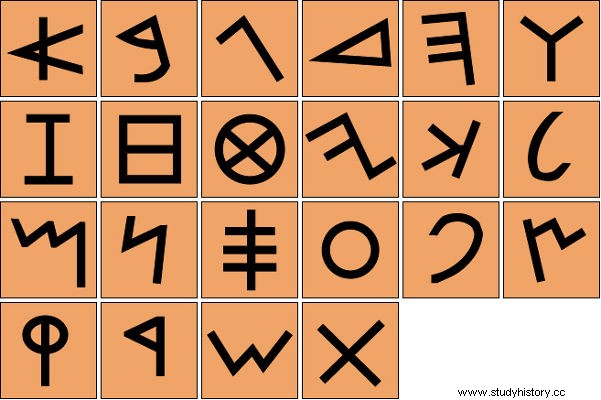
The Phoenicians they were a people who formed a civilization in the region of Palestine, precisely in the regions where today Lebanon and part of Syria and Israel are located. The term “Phoenician” originates from the term “phoinikes ”, which was used by the Greeks to refer to this people because of the purple dye produced by the Phoenicians. The Phoenicians are also known as “Siddonians”, a term that is based on the city of Sidon.
This people was extremely known in antiquity for having excellent traders and navigators, producing the best vessels of its time and for having goods appreciated by different peoples. This characteristic of the Phoenicians is attributed to the geographical condition of the region, which, being mountainous, did not have a suitable soil for the development of large-scale agriculture.
Characteristics of the Phoenicians
The Phoenicians did not develop a centralized civilization because of their organization into city-states. This means that each Phoenician city had a different power structure and economic policy than the others. The main Phoenician cities were Sidon and Shooting , which had a very great economic development, and Byblos , also known as Gebal and the main religious center of this people.
Because of this independence among the Phoenician cities, historians cannot say whether these city-states considered themselves as belonging to the same people. Despite this, historians know that they had a lot in common, such as religious belief, the same language, use of the same form of writing, etc.
The City of Shot appeared around 2750 BC. under the name of Ushu and prospered from an alliance with the Kingdom of Israel, located to the south. The height of this city happened around the 10th century BC, when it had a great influence on the development of Phoenician colonies in different parts of the shores of the Mediterranean Sea.
The region where the city of Sidon developed began to be inhabited around 4000 BC. This city was an important commercial center for the Phoenicians and, around the 10th century BC, it disputed the hegemony of the region with another Phoenician city-state:Tyre. The downfall of Sidon happened exactly at the time of Tire's alliance with the Kingdom of Israel.
Phoenician trade

Alphabet letters created by the Phoenicians around 1100 BC
The Phoenicians were known for their skill in navigation and had a highly developed trade. They developed advanced ships that enabled them to navigate the entire Mediterranean Sea. Phoenician ships were adorned with a horse's head in reference to a god called Yam, considered to be the bringer of chaos and the one who was responsible for keeping the sea calm.
With the growth of the Phoenician city-states, a powerful trade developed in that region. The Phoenicians traded goods appreciated by different peoples of antiquity, such as glass objects, jewelry, ceramics, etc. However, the most prized product of the Phoenicians was the purple dye, which was extracted from a mollusk found on the Phoenician coast.
Phoenician vessels used sails and oars to reach regions far away from Phoenicia, such as Britannia (present-day England). Historians have come to this conclusion because of the existence of many objects produced by the Phoenicians found in these territories. Other places that had commercial contact with the Phoenicians were inhabitants of Cyprus, Crete, Mainland Greece, Egypt etc.
Because of the wide scope of their trade, the Phoenicians developed several colonies in different parts of the Mediterranean Sea. These colonies were created with the aim of having permanent access to new goods and new consumer markets for the products produced by the Phoenicians. The most successful colony of the Phoenicians was the city of Carthage, which came to rival the power of the Roman Empire a few centuries later.
The sheer volume and success of Phoenician trade led these people to formulate the first alphabetic written form of human history. This alphabet, used to keep records of the trade of goods, appeared around 1100 BC. and it was bequeathed to the Greeks, who added vowels to it.
Religion of the Phoenicians
Historians' knowledge of Phoenician religion is extremely limited. One of the main sources is the Bible, which brings an extremely negative view of the religion practiced by the Phoenicians. The Phoenicians were polytheists, and some of their gods were Astarte, Baal, Yam, Melcarte, etc. Each city-state of Phoenicia had a different patron god, with a temple dedicated to him.
Temples were administered by priests who were also of great importance in their societies. The Phoenicians also worshiped their gods in places like forests and mountains. The worship of the Phoenician gods was based on human sacrifice, performed on sacrificial stone altars. In worship of the goddess Astarte, priestesses practiced sacred prostitution.
Decadence of the Phoenicians
This phase characterized by the success of Phoenician maritime trade began from 1500 BC. and peaked in 1200 BC. and 800 BC. However, the Phoenicians' prosperity attracted the greed of several foreign peoples. First, the region was conquered by the Chaldeans of Nebuchadnezzar and then came the Persians of Darius I. Finally, in the 4th century BC, the region was conquered by the Macedonians of Alexander the Great.
In this episode, the highlight is the attack on the city of Tyre, invaded and sacked by the Macedonians. The region was conquered by Alexander after his victory at the Battle of Issus in 333 BC. Although the city of Tire offered resistance, it suffered an eight-month siege and was sacked by this Macedonian king and his enslaved citizens.
Take the opportunity to check out our video lesson on the subject:
